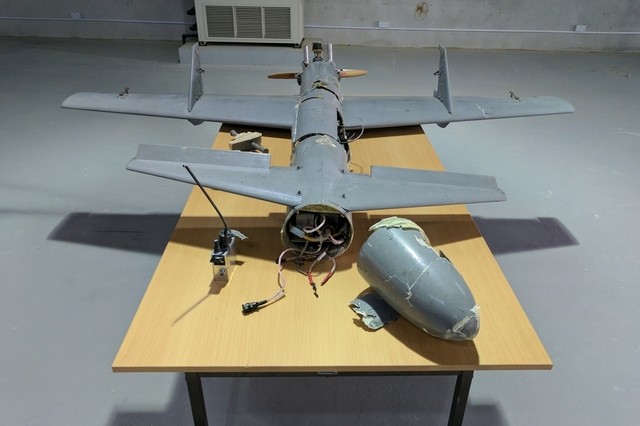Iran has transferred so-called kamikaze aerial drone technology to Yemen’s Houthi rebels who have used them to disable Saudi-led coalition missile defences, according to a new report by an arms tracking NGO.
Instead of firing missiles or other munitions, the drone contains explosives inside its body and has been used to crash into radar components of the coalition’s US-made Patriot anti-missile batteries, UAE military officials told Conflict Armament Research (CAR), a UK-based arms transparency organisation primarily funded by the European Union.
With the radars disabled, the rebels are able to fire volleys of missiles at coalition targets, the report said.
After two years of civil war, including an ongoing bombing campaign by Saudi fighter jets, the Houthis and their allies — former military forces loyal to deposed president Ali Abdullah Saleh — are still able to launch ballistic missiles into Saudi Arabia and have managed to target Yemeni and coalition forces with rockets and missiles.
Last year, CAR documented an arms smuggling route from Iran to the Horn of Africa and Yemen that was used to send light weapons and anti-tank missiles to the rebels.
The aerial attack drones are the latest sophisticated weapon that Iran appears to have sent to the Houthis whom they support, allowing the rebels to target the coalition and US naval vessels in the Bab Al Mandeb with anti-ship missiles and a drone attack boat. Using open-source data, the rebels programme GPS guidance systems in the drones, which do not carry any video or camera sensors.
The drones found appear to be identical to one of four aerial drones the Houthis said last month they had manufactured domestically, which they called the Qasef-1. The CAR report said they are in fact versions of the Ababil-T drone produced by Iran’s Airca Manufacturing Industrial Company.
“These findings strengthen a body of evidence compiled by CAR, which links weapons captured from Houthi and Saleh-aligned forces to transfers from Iranian national stockpiles,” the authors of the report said.
Researchers based their analysis on seven drones and one drone engine which the Houthis used in an attack in Yemen’s Marib governorate. Six of the partially assembled Qasef-1 drones were intercepted by the UAE armed forces in Marib on November 27, 2016, after allegedly being smuggled through Oman into Yemen. The seventh drone crash landed near Aden’s airport, according to UAE forces.
The smuggled drones found in the lorry were missing their nose cones as well as their engines, said one of the CAR researchers Jonah Leff. This may indicate that different components are sent separately.
“The fact that the UAVs [unmanned aerial vehicles] were disassembled while in transit suggests that the Houthis have personnel with technical expertise on UAVs,” Mr Leff said. “It is unlikely that the Houthis developed this technical know-how and newly employed tactics without foreign support. From a military equipment perspective, Iran seems to be playing a hand.”
The serial number prefix of the intercepted drones was identical to the prefix of Iran’s Ababil variants, the report said. The gyroscopes in the drones that researchers were given access to also had a serial number close to an Iranian Ababil drone used by Iranian-backed militia forces in Iraq.
The report said the Chinese-made engine of the crashed drone was identical to the drone engine used in the Marib attack. Both drones were marked with a handwritten “A”, indicating they came from the same batch, while the six new drones were marked with a “B”.
While the vast majority of the Houthis’ arsenal, including ballistic missiles, were seized from government military stockpiles before the war’s outbreak, the relatively small numbers of sophisticated weapons such as drones — and likely training by the Iranians to integrate them into complex asymmetric warfare tactics — have proven to be much deadlier.
Source: The National

